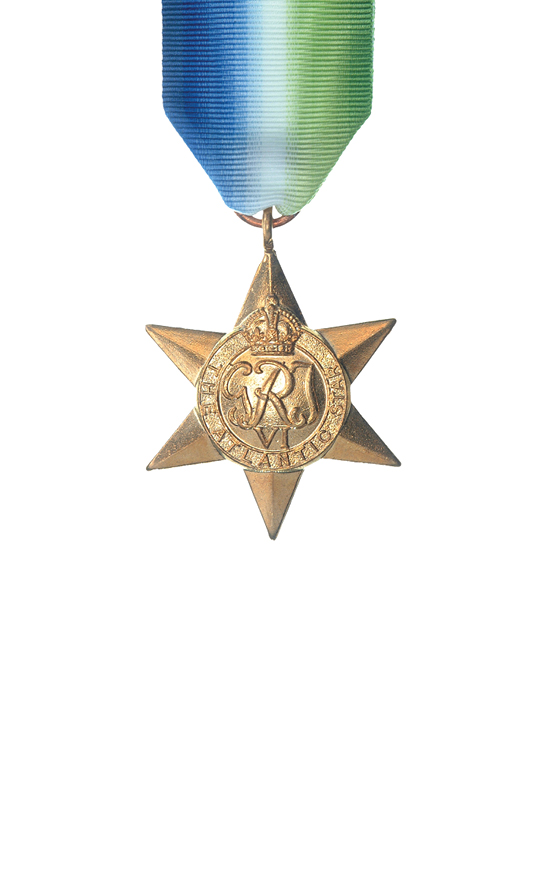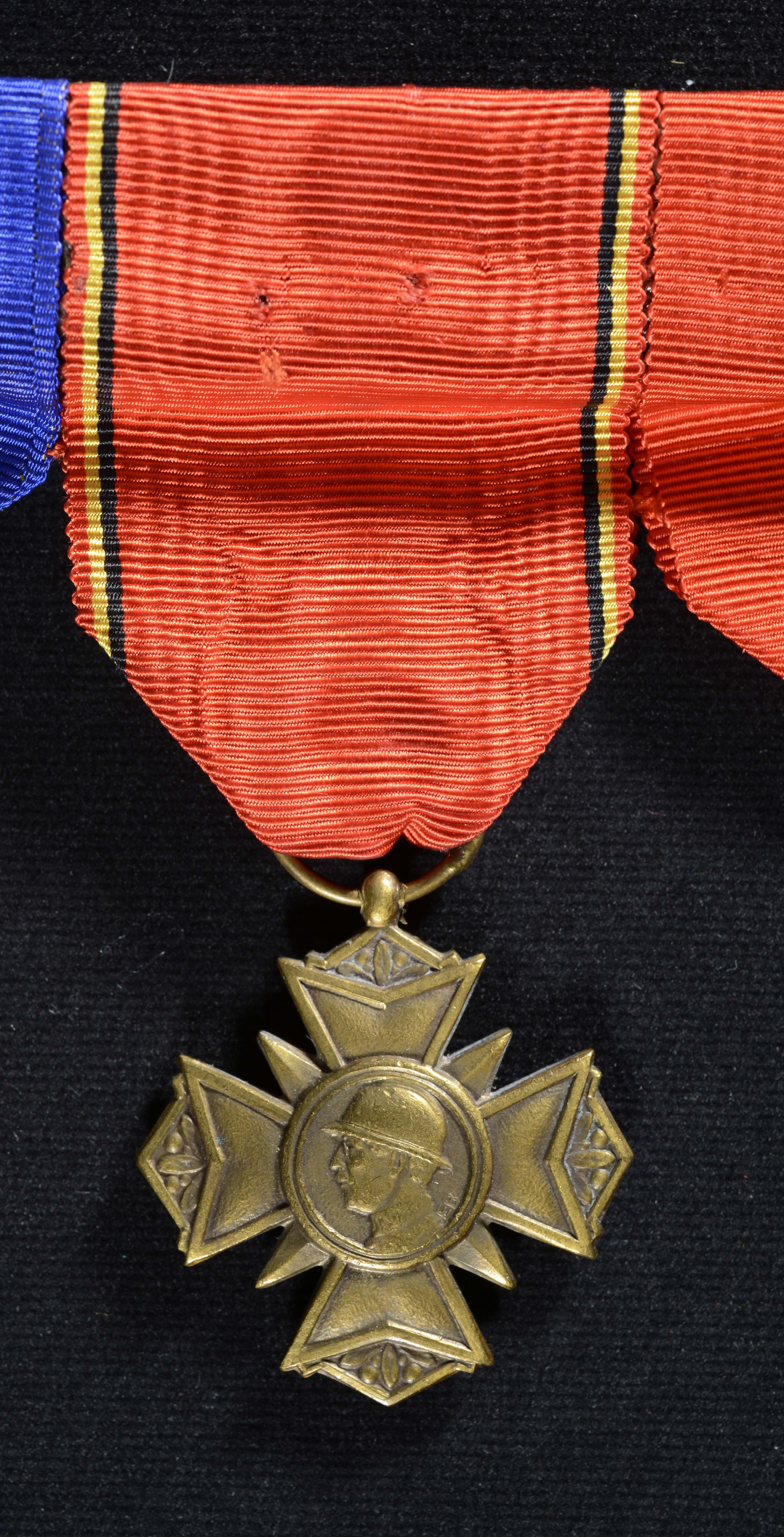

Display No. 8K
SHEPHARD, Albert Charles Manson
Albert ‘Jack’ Shephard joined the Royal Navy in January 1916 as a Boy 2nd Class. He trained in HM Ships Ganges and Pembroke as a Signalman. During the First World War Shephard served in HM Ships Diamond, Dominion, and Commonwealth in the North Sea.
After the war, Shephard served in numerous Royal Navy vessels and shore establishments including time in HMS Hawkins operating on the China station, and HMS Cardiff operating on the Cape of Good Hope station. He was discharged and pensioned in October 1939 as a Chief Yeoman of Signals, only to rejoin one day later on the outbreak of the Second World War.
At the outbreak of the Second World War, Shephard was posted to HMS Malcolm and in 1940 was on board when the ship assisted in the evacuation of Dunkirk. He received a Distinguished Service Medal (DSM) for his conduct in the actions at Dunkirk and against enemy forces in the English Channel. He then served in HMS Mackay which was involved in actions with German vessels in the North Sea and English Channel. From 1943 Shephard served in shore establishments before his final discharge in September 1945.
Awarded medal(s)
Medal Description [Left to Right]:
The Distinguished Service Medal (DSM)

The Distinguished Service Medal (DSM) was instituted in 1914 for senior and junior ratings of the Navy. It was awarded for acts of bravery in the face of the enemy for which the award of the Conspicuous Gallantry Medal was not considered appropriate. It was replaced in 1999 by the New Zealand Gallantry Decoration. The ribbon has three equal stripes: dark blue, white and dark blue with a thin dark blue stripe down the centre of the white stripe.
The British War Medal

The British War Medal was instituted in 1919 to recognise the successful conclusion of the First World War (1914-1918). Its coverage was later extended to recognise service until 1920, recognising mine clearing operations at sea, and participation in operations in North and South Russia, the eastern Baltic, Siberia, the Black Sea and the Caspian Sea.
The Victory Medal

The Victory Medal was awarded in the First World War to all those who had already qualified for the 1914 Star or the 1914-15 Star, and to most persons who had already qualified for the British War Medal. The Victory Medal was awarded to all New Zealand troops serving overseas, except for those who arrived in Samoa after 30 August 1914 and those serving in Great Britain only. It has a unique double rainbow ribbon.
A bronze spray of oak leaves on the medal ribbon denotes that the recipient was Mentioned in Despatches during the period that the medal recognises. To be Mentioned in Despatches a member of the armed forces has had their name mentioned in an official report, written by a superior officer, and sent to a higher command. The report would describe the individual’s gallant or meritorious action in the face of the enemy.
The 1939-1945 Star

The 1939-45 Star is the first in a series of eight campaign stars instituted in 1945 to recognise service in World War Two. The ribbon has three equal vertical stripes of dark blue, red and light blue. The dark blue stripe symbolises the service of the Navy and the Merchant Navy, the red stripe symbolises the service of the Army, and the light blue stripe symbolises the service of the Air Force. The equal width bands represent the equal contributions of the three service arms towards victory. The ribbon was devised by King George VI. Two clasps could be awarded with this medal: ‘Battle of Britain’ and ‘Bomber Command’. Only aircrew would qualify for these clasps although a small number of Fleet Air Arm naval pilots flew for the air force and would be eligible for the ‘Battle of Britain’ clasp.
The Atlantic Star

The Atlantic Star was awarded for service during the Second World War. It was instituted to commemorate the Battle of the Atlantic the longest continuous military campaign in the Second World War running from 3 September, 1939 – 8 May, 1945. Six months naval service or four months air service in the Atlantic, United Kingdom (‘home’) waters or North Russian waters was normally required. The ribbon is watered silk coloured blue, white and green, symbolising service in the oceans. Two clasps could be awarded with this medal: ‘France and Germany’ and ‘Air Crew Europe’. Personnel issued the Atlantic Star who then qualified for either the France and Germany and the Air Crew Europe Stars were awarded a clasp in respect of the second only (as only one clasp could be worn on the star).
The War Medal 1939-1945

The War Medal 1939-45 was awarded across the British Commonwealth to all full-time members of the Armed Forces in the Second World War for 28 days service between 3 September 1939 and 2 September 1945, irrespective of where they were serving. The ribbon is the red, white, and blue of the (British) Union Flag. There is a narrow central red stripe with a narrow white stripe on either side. There are broad red stripes at either edge, the two intervening stripes being blue.
A bronze oak leaf on the medal ribbon denotes that the recipient was Mentioned in Despatches. To be Mentioned in Despatches a member of the armed forces had their name mentioned in an official report, written by a superior officer, and sent to a higher command. The report would describe the individual’s gallant or meritorious action in the face of the enemy.
Royal Naval Long Service and Good Conduct Medal

Awarded to ratings who have served a minimum of 15 years in the Royal Navy (previously 21 or 10 years), the first version of this medal was instituted in 1831 and it is still issued to Royal Navy personnel today. It features the reigning monarch’s head on the obverse and HMS Victory on the reverse with the recipient’s details engraved or impressed on the edge of the medal. This medal was also issued to eligible personnel serving in the New Zealand Division of the Royal Navy from 1921-1941 and then to Royal New Zealand Navy personnel from 1941-1981. In 1985 a New Zealand Royal Navy Long Service and Good Conduct Medal was introduced bearing the exact same design.
Dunkirk Medal
The Dunkirk Medal is an unofficial commemorative medal created by the town of Dunkirk to commemorate the Defence of the town and surrounding area during May and June 1940. In was initially only awarded to French service personnel for service during the defence of the Port of Dunkirk. In 1970 eligibility was extended to include any Allied member involved in Operation Dynamo – the evacuation of Allied forces from the Dunkirk sector between 29 May and 3 June, 1940 and those soldiers evacuated from the beaches. All British servicemen from the Royal Navy, Royal Air Force, Merchant Navy, and the civilian ‘little ship’ volunteers were eligible to receive the award.
Special interest medal(s)
Display No. 26H
Medal Description [Left to Right]:
Cross of the European Confederation of Former Combatants

The medal was issued by the government of France to veterans who took part in Operation Dynamo, the evacuation of Dunkirk. The aim of the European Confederation of Former Combatants is to strengthen links between former allies and enemies in Europe, to foster peace, security, cooperation and friendship and to defend human rights. During the Cold War, it acted as a point of contact between the opposing sides and more recently it has worked to ease the path of the former Soviet Bloc countries into a united Europe.
King Albert I Veterans’ Medal (or Cross)

This unofficial medal was made available to purchase in the late 1960s and 1970s to all Allied veterans who had served in Belgium during the First World War, or their next of kin. It was issued by the government of Belgium.
Royal Federation of the Veterans of King Albert I 1948-1973

A Belgian commemorative medal. The Royal Federation was established in 1948 to commemorate King Albert I and the veterans of the First World War in Belgium. Issued by the government of Belgium.


